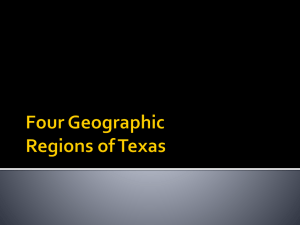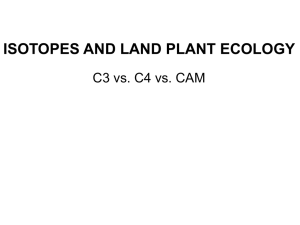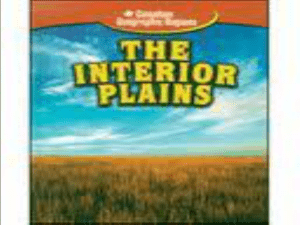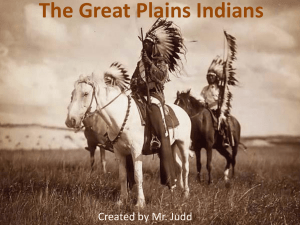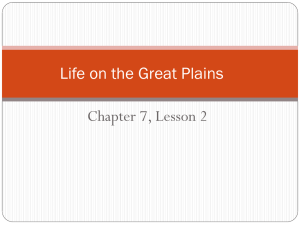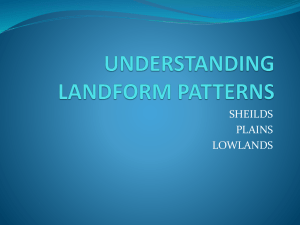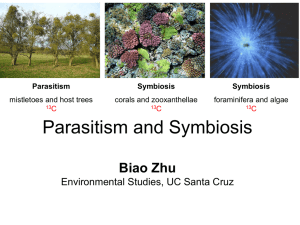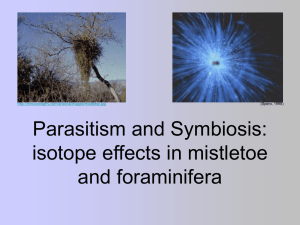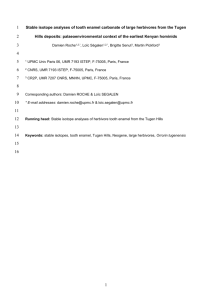PPT Presentation
advertisement
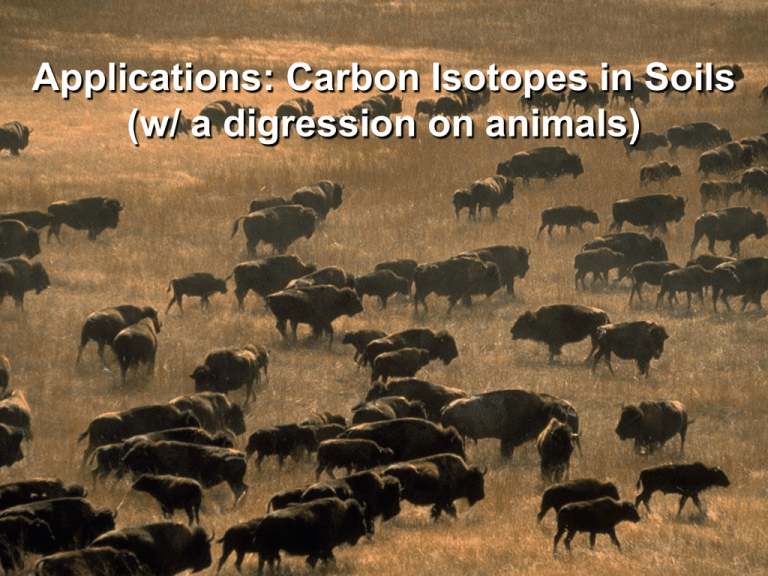
Applications: Carbon Isotopes in Soils (w/ a digression on animals) Grassland composition varies with climate Shift in C4 abundance %C4 = -0.9837 + 0.000594 (MAP) + 1.3528(JJA/MAP) + 0.2710 (lnMAT) The modern prairie is a C4-dominated grassland Map from Tieszen et al. (1997) Regression from Paruelo & Lauenroth (1996) 13C shifts with change in plants Soil isotopes Biomass (STATGO) QuickTime™ and a decompressor are needed to see this picture. 13C of soils and roots vs. depth QuickTime™ and a decompressor are needed to see this picture. von Fischer et al. 2008 13C shifts with change in plants QuickTime™ and a decompressor are needed to see this picture. 13C shifts with climate QuickTime™ and a decompressor are needed to see this picture. C3-to-C4 balance is also affected by pCO2 C3 plants Crossover Temperature Quantum Yield C4 plants (moles C fixed per photon absorbed) Today (360 ppm) LGM (180 ppm) 3 6 9 12 15 18 21 24 27 Temperature (°C) 30 Two questions about Great Plains ecosystems At the LGM, was there less C4 biomass (because of lower temperatures) or more C4 biomass (because of lower pCO2)? When (and why) did C4 grass come to dominate Great Plains ecosystems? Use isotopes in animals and soils to track C3-to-C4 balance Why Texus? Climate means from 1931-1990 From New et al. (2000) Archived at www.ipcc-ddc.cru.uea.ac.uk N High Plains 36¡N OKLAHOMA 34¡N Texas vegetation today NEW MEXICO High Plains Rolling Plains TEXAS 32¡N Piney Woods Llano Edw ards Uplift Plateau Trans Pecos 30¡N 28¡N BP S. Texas Brushland MEXICO Gulf Coas t Mars h&Prairie s 26¡N From Diamond et al. 1987 106¡W 104¡W 102¡W 100¡W 98¡W 96¡W 94¡W Another question: Were the plains and plateau regions covered by a boreal forest at the LGM? Proboscideans Horses - Bison Holocene Late Glacial Holocene bison Last Glacial Maximum Ingelside horses Pre-LGM Initial conclusions from isotope studies of Texas mammals 1) No changes in mean δ13C value through time (ANOVA). 2) Bison and mammoths are grazers. They can be used to monitor C3 to C4 balance on Pleistocene grasslands. 3) Mastodons are browsers. Their presence suggests tree cover. 4) Pleistocene horses ate lots of C3 vegetation, even when bison and mammoths had ~100% C4 diets. Horses were mixed feeders. What's next? Compare %C4 from mammals to values simulated via modeling. 1) Use Quaternary climate model output, and estimate %C4 biomass using the Regression Equation. 2) Use the same climate model output, but estimate %C4 biomass as the percentage of growing season months that are above the appropriate Crossover Temperature. %C4 Grass from Regression Model Holocene 0-10 Ka Post-LGM 10-15 Ka %C4 plants in grazer diets Mammuthus Bison Mammut present LGM 25-15 Ka Holocene model driven by modern climate data from New et al. (2000). LGM and Post-LGM models driven by GCM output from Kutzbach et al. (1996) (archived at www.ngdc.noaa.gov/paleo/paleo.html) Quaternary Prairies from animals 1) Pleistocene horses were mixed feeders, not grazers. 2) Despite climate change, %C4 biomass is remarkably constant through time. 3) Always lots of C4 biomass on plains and plateaus and no mastodons. No LGM boreal forest in the region. 4) Only climate-vegetation models that account for changes in pCO2 as well as temperature provide reasonable %C4 estimates in parts of the Quaternary with different atmospheric compositions. Koch et al. (2004) P3 Quaternary Prairies from soils QuickTime™ and a decompressor are needed to see this picture. QuickTime™ and a decompressor are needed to see this picture. Quaternary Prairies from soils δ13C of paleosol carbonates from Pakistan Quade et al. (1989) Development of the Asian monsoon revealed by marked ecological shift during the latest Miocene in northern Pakistan. Nature 342: 163-166. Diet shifts in Mio-Pliocene Mammals Cerling et al. (1997) Isotopic evidence for dietary change in Great Plains horses • Prior to the late Miocene, all horses ate mostly C3 plants • 1st evidence for C4dominated diets is at 6.6 Ma • After 6.6 Ma, horses from Texas to Nebraska had a wide range of diets Passey et al. (2002) Isotopic evidence for dietary change in Great Plains horses • Prior to the late Miocene, all horses at mostly C3 plants • 1st evidence for C4dominated diets is at 6.6 Ma • After 6.6 Ma, horses from Texas to Nebraska had a wide range of diets Passey et al. (2002) Paleosol localities in the Central and Southern Great Plains Modern C3 soils with <100 mm precipitation δ13C values of Great Plains paleosol carbonates n = 274 δ13C values of Great Plains paleosol carbonates n = 274 δ13C values of Great Plains paleosol organics n = 20 δ13C values of Great Plains paleosol organics n = 20 Isotopic evidence from new Great Plains faunas CO2 drop or climate change? Toto, I have a feeling we're not in Asia anymore. Age (Ma) Globally synchronous at 7 Ma? Other sections in East Africa Levin et al. (2004) 13C (VPDB) A late Miocene drop in pCO2? Based on 13C records in organic biomarkers Pagani et al. (1999) Pearson & Palmer (2000) Age (Ma) 5 0 Plt. 18O (‰) 4 3 2 13C(‰) 1 0 -1 01 Decrease in MAT. 10 Increase in seasonality. Decrease in length of growing season. 20 Loss of winter growing season. 30 40 Zachos et al. (2001) 2


